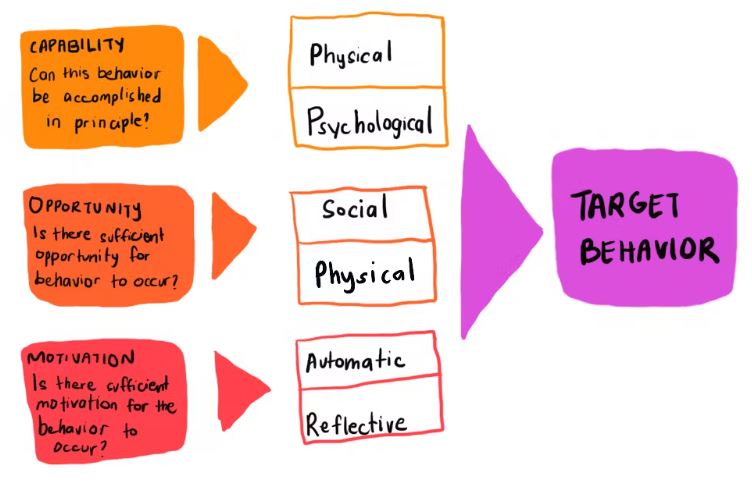Decoding Behaviour Change – An Overview of the COM-B Model
Understanding what drives human behaviour is fundamental for designing effective interventions—whether in health, policy, marketing, or organisational change. For researchers and strategists alike, the COM-B model offers a robust, evidence-based framework for analysing behaviour and informing intervention design.
Developed by Professor Susan Michie, Maartje van Stralen and Robert West in 2011, the COM-B model is a foundational framework that explains behaviour (B) as the result of an interaction between three components: Capability (C), Opportunity (O), and Motivation (M). According to the model, for any behaviour to occur, a person must have the capability to perform it, the opportunity for it to take place, and the motivation to carry it out.
This simple yet powerful model allows for a diagnosis of the causes of problematic behaviours and the design of effective interventions to change them.

Source: The Decision Lab
The core components of COM-B
1) Capability
Capability refers to an individual’s psychological and physical ability to perform a behaviour.
- Physical Capability: Having the physical skills or strength required for the behaviour
- Psychological Capability: Possessing the knowledge, understanding, or mental capacity needed to engage in the behaviour
A lack of capability might manifest as skill gaps, cognitive overload, or misinformation. Interventions here often involve education, training, or skill-building exercises.
Example: A person may want to switch to a plant-based diet but lacks the nutritional knowledge or cooking skills to do so.
2) Opportunity
Opportunity covers all external factors that either enable or prompt the behaviour, and includes both physical and social elements.
- Physical Opportunity: The environmental context—time, resources, infrastructure.
- Social Opportunity: Cultural norms, social cues, peer influence, and interpersonal dynamics.
Opportunity is frequently overlooked but often where meaningful change can be achieved. Strategies may include environmental restructuring, policy change, or social support systems.
Example: An employee might be willing to cycle to work but is limited by a lack of bike racks or shower facilities.
3) Motivation
Motivation encompasses the internal processes that energise and direct behaviour. It includes both:
- Reflective Motivation: Conscious decision-making, planning, and evaluation.
- Automatic Motivation: Emotions, habits, impulses, and associative learning.
Effective interventions here might use persuasion, incentives, or habit-formation techniques.
Example: Someone may know the health benefits of quitting smoking (reflective) but still struggle due to nicotine cravings and stress-induced habits (automatic).
Why COM-B Works for Researchers
For research and insights professionals, the COM-B model serves as both a diagnostic tool and a strategic framework. It enables systematic mapping of behavioural drivers, helping to:
- Identify barriers and enablers of target behaviours
- Segment audiences based on behavioural needs rather than demographics alone
- Design tailored interventions grounded in behavioural science
- Bridge the gap between research insights and actionable strategy
Rather than jumping to solutions, COM-B encourages structured thinking around why a behaviour is or isn’t happening—aligning closely with the goals of behavioural diagnostics, UX research, policy evaluation, and public engagement.




